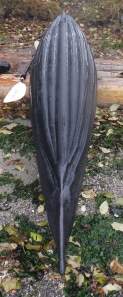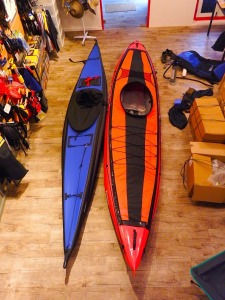Discontinued
Early owner’s review

Feathercraft’s short-lived Aironaut IK looked like a breath of fresh air. As with their folders, FC managed to turn the usual IK sow’s ear into a very silky looking purse. With all kayaks, it’s the sensation of gliding or responsiveness to paddle strokes that has as much appeal as being in the outdoors. And judging from looks alone, the Aironaut did that better than other IKs even if the concept may have been flawed and the boat was discontinued.
The Airo’ was pitched as a nippy recreational day boat for folks who find Feathercraft folding kayaks a faff to set up on the spur of the moment (left) and a pain to store or transport fully assembled.
It’s the relative effort and complexity as well as assembly time that can kill spontaneity, especially if you’re at an age when you’re no longer as supple as a leaping salmon. I’ve also encountered the fragility of ally-framed folders – something to which IKs are immune, though both are susceptible to cuts and abrasions.
A few years ago I briefly owned Feathercraft’s Java, what they rightly called a ‘sit on top’ IK, but I didn’t get on with it (read the link). The Airo was a conventional sit in IK, complete with a fixed deck like the Gumotex Framura. By IK standards, even the Aironaut name was clever too, suggesting a light, cutting-edge boat. From the images it’s got to be the slickest-looking IK out there, though the competition isn’t that great.

The magic numbers are: 4.5m (14’ 9”) long, just 66cm (26”) wide, a weight of only 9kg (20 lbs) but a modest payload of 136kg. The rest you read here is my usual speculation based on those details and the photos I have pinched from the Feathercraft Aironaut webpage and eBay.
As with my old Incept K40, using ‘plastic’ coated fabrics means it can all can be heat-welded together, which you presume is cleaner and less expensive than gluing by hand. Urethane-coated nylon may not sound such a ‘high quality, technical fabric’ (to quote the FC blurb), but packboat manufacturers are notoriously cagey about fabric specifics. As with Alpacka packrafts, exactly what type of urethane is key, as is the composition of the nylon base. Both may be custom specified from a source manufacturer to deliver certain properties. A nylon weave base fabric is supposedly more stretchy than polyester which is good against spikes, but less good in containing a rigid inflatable form. That’s probably why it needed to run a such a high pressure.
My Incept was a fast IK, aided by a notably slick PVC-urethane coating over a ‘1100 polyester dtex’ (= about 1000D) base. Knowing that, suddenly the Airo’s 420D doesn’t sound so robust, but that’s how Feathercraft managed to halve the weight of a K40, which otherwise has very similar dimensions. Another clue might be in the payload of 136kg; the Airo’s many tubes may add up to a relatively small volume. The Incept was rated at 160kg.
They achieve that amazing weight by fabricating the Airo from 210D urethane-coated nylon on the deck and multi-tubed black sides, and 420D in the hull (hard to tell the later two apart in most pics). So it’s a regular three-chamber IK. When I recall the Supai packraft was made from 75D polyester, triple that for the sides and six times for the hull sounds reassuring, though direct denier comparisons are misleading. It’s about weave density not actual fabric thickness.
The Airo had Halkey inflation valves like the Incept, and pressure-release valves on all three chambers. PRVs are vital so the seams won’t stress and pop if it gets hot (as happened to my Java). I’m always a little perturbed that my high pressure Grabner had no PRVs and added them to my Gumotex Seawave’s sides for protection with sun-induced over-pressurisation.

However, see the link at the bottom of the page. It seems the combination of a long, solo IK made from a thin fabric needed a high 5psi rating to not sag in the middle, but even with PRVs all round, there were reports of a couple of Aironauts blowing apart irreparably which may be why it was discontinued (FC claimed ‘high costs’). Soon after FC sadly closed down for good. You might think: fit lower-rated PRVs to spare the hull, but if the boat was designed to work at 5psi, anything less would see it sag like a Sevylor bloat, especially with a girthsome paddler.

A blown I-beam in the floor. Hard to repair without opening the boat right up.
Also, like my old Sunny, Incept, Grabner and Seawave (left, alongside and Airo), the Aironaut is a European-style ‘tubeless’ IK with no slip-in sponsons (‘inner tubes’) to give a hull shell its form.
Perhaps that too was necessary to run a high 5psi (0.34 bar) pressure, something which requires a good pump as well as good construction if it’s not to leak at weak points.
Once on the water though, high pressure hulls have real benefits in terms of hardshell-like hull rigidity and paddling efficiency. Look at the pictures and see how straight the kayaks appear, even allowing for light paddlers (and compare to my Java here). Then factor in the Airo’s Java-like cheese-cutting bow and I suspect this may have been a fast IK, and all without clumsy and bulky stiffening rods or dropstitch floors. It’s no great surprise that it was Feathercraft who managed it, but it seems it the design was flawed.

FC seem keen on you using their sea sock insert which fits around the coaming and stops the boat filling right up in a capsize. The thought of snagging that while trying to get out in a hurry would be a worry.
It’s also a little unnerving that they include a paddle float in the package (left), admitting perhaps that the 26-inch wide Aironaut was a tippy IK and getting back into the cockpit would be tricky on the high and buoyant Aironaut. I tried it with the Incept once, but as we know, practicing near the shore with a mate taking photos is not the same as tipping over out at sea, especially when alone. You would be better off getting the knack of rolling.

At 75cm long (26.5 inches) the Aironaut’s cockpit hatch is the same as my mate’s Big Kahuna. In all my clobber and fluctuating girth I wouldn’t want it any smaller, though I imagine there is more’ squidging’ space and no Kahuna alloy bars getting in the way; instead there are the thigh straps – essential for rolling and bracing. You also got a spray skirt plus a detachable, low profile skeg which is also a good idea at sea; the latter in my experience is much less faff than a rudder which I’ve found to be inadequate anyway once a tailwind gets beyond a certain strength. Good on FC for including all this in the package. Grabner and others take note.
The Feathercraft Aironaut was made in Canada and went for around CAN$3000 or the same price as the otherwise similar Incept K40 or a good Grabner.
Compared directly with the K40, the Aironaut was nearly half the weight, had a fixed deck which to me limited the appeal, had a simple skeg instead of a complex rudder, was a little narrower but a little longer, ran less payload and was supposedly tippy which, however they managed it, the K40 never was. Judging by other FCs I’ve tried and owned, I bet the Airo was better made than the K40 too, though that weight-saving fabric choice appears to be at the a cost of durability.
Airo flaws; a discussion thread – Paddling impression










FC Java 
K40









